| The GAFFers | |
|---|---|
 The Astronauts of Group 12 | |
| Year selected | 1987 |
| Number selected | 15 |
NASA Astronaut Group 12 (the GAFFers) was a group of 15 astronauts announced by NASA on June 5, 1987. [1]
| The GAFFers | |
|---|---|
 The Astronauts of Group 12 | |
| Year selected | 1987 |
| Number selected | 15 |
NASA Astronaut Group 12 (the GAFFers) was a group of 15 astronauts announced by NASA on June 5, 1987. [1]
The group's informal nickname is an acronym for "George Abbey Final Fifteen". [58] Of this group, Mae Jemison would become the first female African-American in space, [59] Bruce Melnick the first Coast Guard aviator in space, [60] while Michael Foale would fly aboard the Mir space station. [37] At the time of the Columbia accident in 2003, William Readdy was Associate Administrator for Space Flight [27] and Kenneth Bowersox was commanding the Expedition 6 crew on the ISS. [6] Chilton, after leaving NASA, became the first NASA astronaut to become a General in the U.S. Air Force [61] (Lt. Gen. Thomas Stafford, USAF, [62] and VADM Richard Truly, USN [63] were three-star officers) and was commander of U.S. Strategic Command from October 2007 until January 2011. [61]
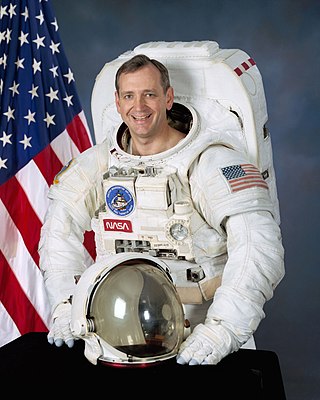
Thomas Dale Akers is a former American astronaut in NASA's Space Shuttle program.

Kenneth Dwane "Sox" Bowersox is a United States Navy officer and former NASA astronaut. He is a veteran of five Space Shuttle launches and an extended stay aboard the International Space Station. When he launched on STS-73 at the age of 38 years and 11 months, he became the youngest person to command a Space Shuttle.
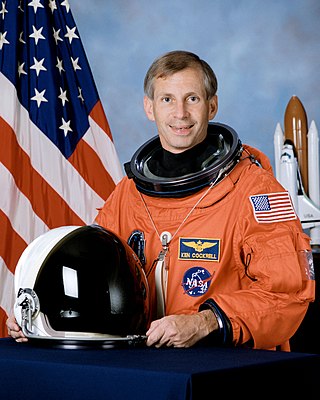
Kenneth Dale "Taco" Cockrell is a retired American astronaut, engineer and a veteran of five Space Shuttle missions. He served as Chief of the Astronaut Office from 1997 to 1998.

William McMichael "Bill" Shepherd, , is an American former Navy SEAL, aerospace, ocean, and mechanical engineer, and NASA astronaut, who served as commander of Expedition 1, the first crew on the International Space Station. He is a recipient of the Congressional Space Medal of Honor.

Nancy Jan Davis is a former American astronaut. A veteran of three space flights, Davis logged over 673 hours in space. She is now retired from NASA.

Curtis Lee "Curt" Brown Jr. is a former NASA astronaut and retired United States Air Force colonel.

Brian Duffy is a retired U.S. Air Force colonel and a former NASA astronaut. He flew aboard four Space Shuttle missions.

Linda Maxine Godwin is an American scientist and retired NASA astronaut. Godwin joined NASA in 1980 and became an astronaut in July 1986. She retired in 2010. During her career, Godwin completed four space flights and logged over 38 days in space. Godwin also served as the assistant to the director for exploration, Flight Crew Operations Directorate at the Johnson Space Center. Since retiring from NASA, she accepted the position of professor in the Department of Physics and Astronomy at the University of Missouri.

Gregory Jordan "Greg" Harbaugh is an aeronautical/astronautical engineer and former NASA astronaut. He flew on four space shuttle missions as a mission specialist with responsibilities that included Remote Manipulator System (RMS) operation and Extravehicular Activity (EVAs). He performed three spacewalks during the shuttle missions including in support of repair/refurbishment of the Hubble Space Telescope.

Donald Ray McMonagle is a former astronaut and a veteran of three shuttle flights. He became the Manager, Launch Integration, at the Kennedy Space Center, Florida, on August 15, 1997. In this capacity he was responsible for final shuttle preparation, launch execution, and return of the orbiter to KSC following landings at any other location. He was chair of the Mission Management Team, and was the final authority for launch decision.

Mario Runco Jr. is a former United States Naval officer and NASA astronaut. He was selected as an astronaut with in 1987. He flew three Space Shuttle missions, performed a spacewalk on his second mission, and is now retired both from NASA and the U.S. Navy.

James Shelton Voss is a retired United States Army colonel and NASA astronaut. During his time with NASA, Voss flew in space five times on board the Space Shuttle and International Space Station. He also served as deputy of Flight Operations for the Space Station Program Mission Integration and Operations Office. While participating in ISS Expedition 2, he and Susan Helms conducted an 8-hour and 56 minute spacewalk, the longest to date.

NASA Astronaut Group 13 was a group of 23 astronauts announced by NASA on 17 January 1990. The group name came from its selection of a black cat as a mascot, to play against the traditional unlucky connotations of the number 13.

NASA Astronaut Group 16 was a group of 44 astronauts announced by NASA on May 1, 1996. The class was nicknamed "The Sardines" for being such a large class, humorously implying that their training sessions would be as tightly packed as sardines in a can. These 44 candidates compose the largest astronaut class to date. NASA selected so many candidates in preparation for the anticipated need for ISS crew members, along with regular shuttle needs. Nine of the 44 astronauts selected were from other countries including 5 from Europe and 2 from Canada and Japan.
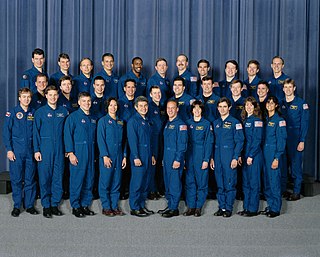
NASA Astronaut Group 17, were chosen by NASA in 1998 and announced on June 4 of that year. The group of 32 candidates included eight pilots, 17 mission specialists, and seven international mission specialists who became NASA astronauts. They began training in August 1998.
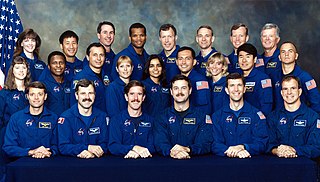
NASA Astronaut Group 15 was a group of 23 NASA astronauts announced on December 8, 1994. Group members adopted The Flying Escargot as their moniker, in reference to two members of the group being from France. The group featured ten pilots, nine mission specialists, and four international mission specialist trainees from France, Canada and Japan.

NASA Astronaut Group 9 was a group of 19 NASA astronauts announced on May 29, 1980, and completed their training by 1981. This group was selected to supplement the 35 astronauts that had been selected in 1978, and marked the first time that non-Americans were trained as mission specialists with the selections of ESA astronauts Claude Nicollier and Wubbo Ockels. In keeping with the previous group, astronaut candidates were divided into pilots and mission specialists, with eight pilots, eleven mission specialists, and two international mission specialists within the group.
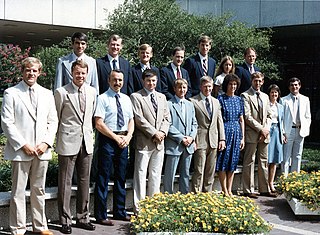
NASA Astronaut Group 10 was a group of 17 astronauts that were announced on May 23, 1984 and consisted of seven pilots and ten mission specialists. Although selected in 1984, no member of the group would fly until 1988 due to the Challenger disaster and the resulting grounding of the Space Shuttle fleet.

NASA Astronaut Group 14 was a group of 24 astronauts announced by NASA on 31 March 1992. The group's name derived from The Muppet Show skit "Pigs in Space" and from the group's sponsorship of a pot-bellied pig at the Houston Zoo.
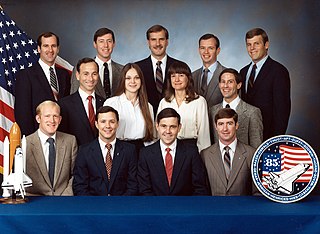
NASA Astronaut Group 11 was a group of 13 NASA astronauts announced on 4 June 1985.